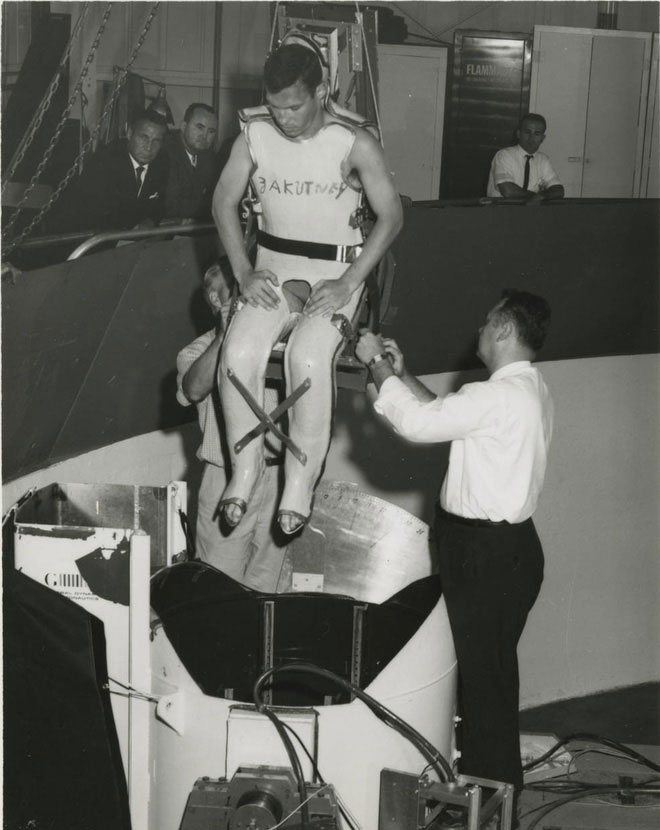NASA can bring astronauts to space by 11 hearing-impaired men
Before bringing people into space, NASA had to conduct a thorough research on the effects of zero gravity on the human body over a long period of time.
In order to serve this research, in the late 1950s, NASA joined the US Naval Aviation School of Medicine to establish a research program with the help of 11 deaf men , aged 25 to 48, from Gallaudet (now Gallaudet University) . History has honored these 11 men as 'Gallaudet Eleven - Eleven people from Gallaudet' , this is their name:
- Harold Domich
- Robert Greenmun
- Barron Gulak
- Raymond Harper
- Jerald Jordan
- Harry Larson
- David Myers
- Donald Peterson
- Raymond Piper
- Alvin Steele
- John Zakutney

Participant researcher John Zakutney is being lowered to a centrifuge.
Except for one person, all of them had hearing loss from childhood due to sequelae of meningitis. Meningitis also damages the vestibular system of the inner ear, making these people 'immune' to motion sickness or any other means of transportation.
Over the course of a decade with many different tests, researchers have been investigating the non-reactive ability of 11 participants for motion sickness, both physiologically and psychologically, since then. give detailed reports about their feelings and change their perceptions. These experiments help clarify how the sensory system works in case the inner ear nervous system does not receive normal gravity signals. (As is the case with these deaf boys and like when people are on a spacecraft).
Harry Larson, one of the study participants, said, 'Our difference is what this study is in need of.'
These experiments focus on the physiological balance and adaptation of objects in many different environments. One of them asked four deaf men to stay in a 6-meter-diameter room, continuously rotating slowly for 12 days, maintaining a motion speed of 10 revolutions per minute.

Participants study Harry Larson standing in a slow-moving room.
There is a special experiment conducted on a ferry off the coast of Nova Scotia, to record the reaction of the research group to the floating movements of the waves. And as a result, while deaf people casually play cards and enjoy the cruise, researchers are so drunk that they have to stop testing.
Another study allowed subjects to participate in a series of non-gravity flights of the famous 'Vomit Comet' aircraft, to study the association between body orientation and gravity signals. .

The participants studied in the gravity plane departing from the Naval Air Station in Pensacola.
The boys from Gallaudet said that they did not experience any adverse physical effects, but on the contrary, were comfortable enjoying the long experiment. Barron Gulak said: 'Looking back, it is really scary . But at that time we were still young and not afraid of adventure.'
Based on the results obtained from experiments conducted throughout the decade, researchers have a better understanding of the sensory system as well as its reactions to external gravity environments. It can be said that Gallaudet Eleven did not manage very hard and devoted himself to the process of studying the motion sickness and moving vehicles, as well as the adaptation of the human body to the space environment.
On April 11, 2017, NASA historian Bill Barry honored the agency to attend the opening ceremony of the Gallaudet University museum and the Deaf Difference + Space Survival exhibition. Organized by Maggie Kopp, also a student at Gallaudet University, the exhibition highlights the great but silent contributions of 11 Gallaudet alumni during NASA's research from 1958 to 1968.

Ribbon cutting ceremony inaugurated the exhibition at Gallaudet University Museum.
From left to right: Gallaudet Margaret Kopp Exhibition Organizer, NASA Bill Barry Historian, Dr. Paul DiZio - Ashton Graybiel Space Orientation Laboratory at Brandeis University, 3 people holding scissors are 3 of 11 the young Gallaudet joined NASA research in the past: Harry O. Larson, Barron Gulak, David O Myers, University Director Gallaudet Roberta J. Cordano, and Principal Carol J. Erting.
- America spends more on Russian rents to bring people to space
- The US spends $ 55 million on NASA to promote the creation of space for astronauts
- ISS first picked up 4 female astronauts at the same time
- Fire alarm system for the hearing impaired
- NASA wants to bring 3D printers to ISS next year
- This high-tech jacket allows the hearing impaired to 'feel' the music on their skin
- Hearing aids control thinking
- NASA recruited astronauts for Mars exploration campaign
- NASA set up funding for taxi systems in space
- Sign language translation system
- NASA spends a lot of money to develop a
- Details of NASA's 5-stage plan to bring people to Mars
 The most famous scientific failures in history
The most famous scientific failures in history The son carries the 'bad gene' of genius Albert Einstein
The son carries the 'bad gene' of genius Albert Einstein Isaac Newton
Isaac Newton The birth of the microscope
The birth of the microscope